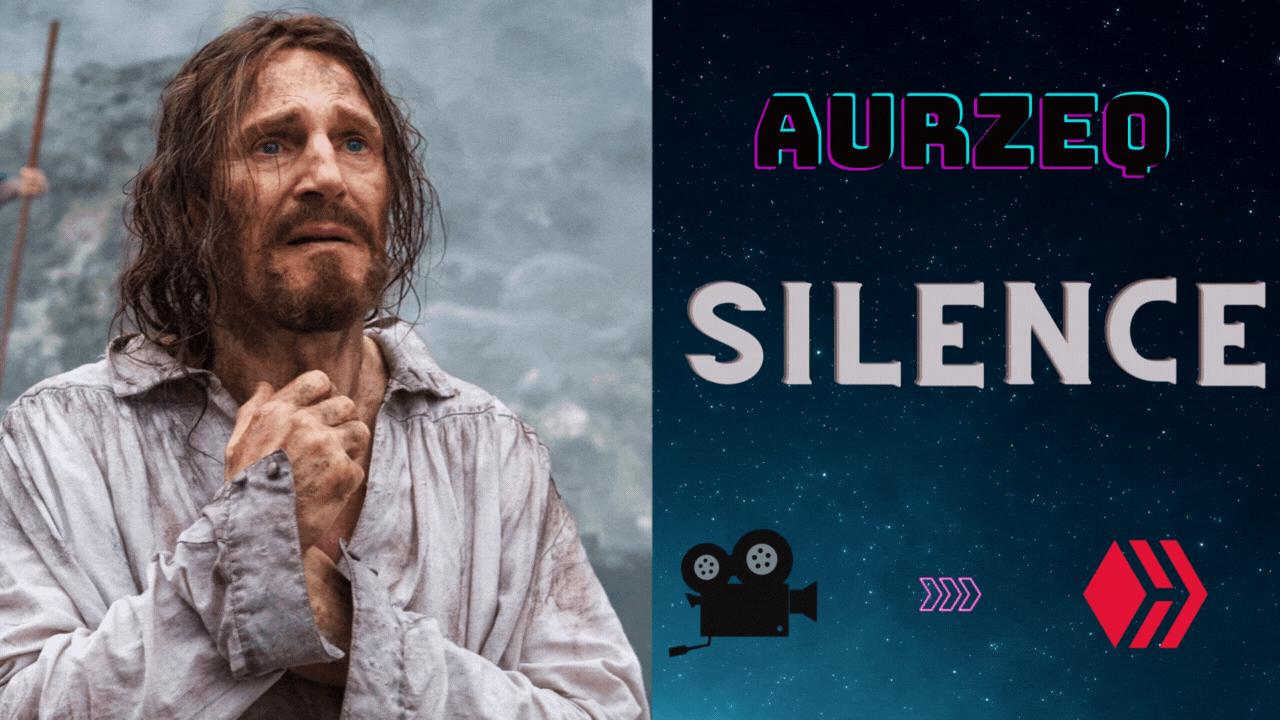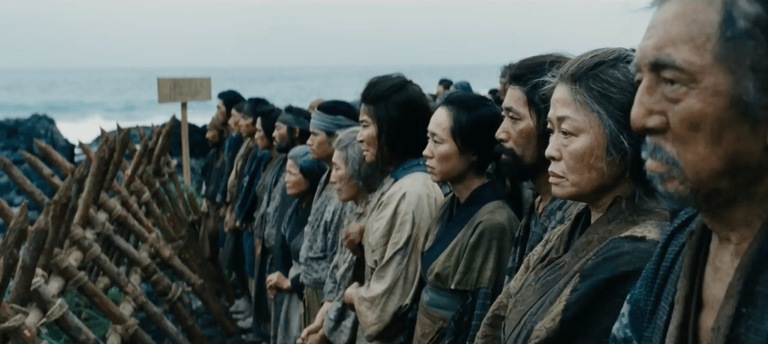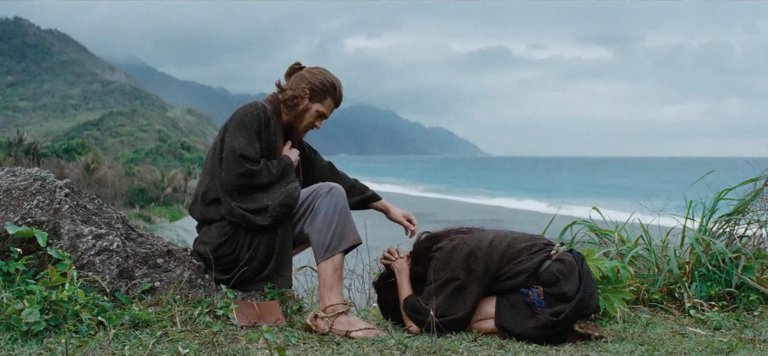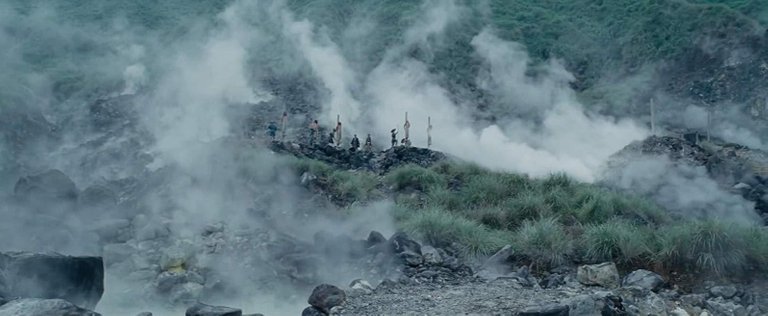A review of "Silence": A wonderful movie about culture, religion and superbia

Source of the background image
Plot
After a century of nonviolent evangelization in Japan, the Tokugawa era saw the start of the ferocious persecution of Christians. Around 1600, it is believed that nearly 300,000 Japanese were converted by European missionaries. However, in 1614, an edict evicted all Catholic priests and authorized the feudal authorities to use all available methods to combat Christianity. This inferno of abjurations, tortures, death sentences, and conversions is where the story of Silence and the book of the same name by Shūsaku Endō begin. A desperate letter from their spiritual father Ferreira (Liam Neeson), who had relocated to Japan years before, is received by two young Jesuits in 1640. The letter is outdated, and there are rumors that Ferreira has now abandoned Christianity. Thus, Rodrigues (Andrew Garfield) and Grape (Adam Driver) decide to sneak into Japan to follow Ferreira's trail and carry on the evangelism that the master had interrupted. They discover a nation controlled by the shoguns and ripped apart by persecution.

Source

Why should you watch it?
Silence is a movie about a confrontation between ideologies, schools of thinking, and cultures, each of which attempts to impose itself from the outside without showing any genuine curiosity or openness towards the other, in addition to the personal narrative of a man in faith. There is violence on both sides. The introduction of a foreign system of thought under the pretense that it is preferable is always an abuse with grave repercussions, regardless of the good intentions, the depth of conviction that they are carrying out God's will by saving souls from damnation, or the palpable comfort that the Christian religion appears to give to the people of the coastal villages with which the two young Jesuits come into contact.
Cultural identity needs the utmost respect since it is more significant to society and to an individual than any political or religious conviction, as well as any economic opportunity.

Source
Shusaku Endo, the author of the book on which Silence is based, makes this admission to us, and the Scorsese and Cocks' screenplay embraces it with admiration and deference. It is a valuable message for anyone wishing to constructively analyze the origin of fundamentalism: coexistence, contamination, and enrichment between cultures are only possible if the confrontation is on an equal footing if the Disaster inevitably results from one culture's superior attitude toward another.
The movie wants also to explain the difference between these two worlds. Christians are forced to abjure in the form of the fumie</>, the obligation to desecrate holy objects, throughout the entire movie. For a Westerner, the icon is merely a depiction and not an object of devotion. And that is where the distance between Japan and the West is irreconcilable. The fumie isn't certainly a formality to a Japanese person! For a Westerner, trampling on a religious icon can only be an act of display. In fact, Rodrigues doesn't think twice to yell, "Trample! Trample!" in an effort to save a few lives.
In the face of brutality, inner faith will not be shaken since the image is all there is. Instead, since they lacked the courage to step on a cross, hundreds of Japanese perish. There is an insurmountable, entrenched emotion that links the substance with the fetish. The psychological violence of the power emissaries is based on this component.

Source
Rodrigues is a superb man; in his suffering, he often parallels Christ. Scorsese spends a lot of time at the beginning of the movie focusing on a picture of Christ, which in the reverse scene is precisely placed on Rodrigues' face. Later, the identification is made clearer: when Rodrigues looks in a river's mirror, he sees Christ's face rather than his own. When Rodrigues is confronted with the arrogance of his own stubborn desire to identify with Christ and the realization that Christianity in Japan is nothing more than a perverted version of the faith they claimed to spread, the sirens of abjuration become more and more persuasive to him. This is especially true when he is given the option of choosing a wealthy life in Japan complete with a wife.

Source
Rodrigues is made to see that he will never be able to match Christ as a man (and that any attempt to imitate Christ does not escape being an act of pride). The same holds true for Westerners' pride in their ability to express the value of Liberty through their culture. The movie by Scorsese is an allegory of ambiguity that is difficult to resolve. The Western spectator is emphasized in his persuasion that he belongs to a civilization that holds the supremacy of individual freedom in light of the Japanese civilization described in "Silence," despite the fact that there is no faith without genuine inner adhesion and, consequently, without freedom. And when he tends to associate himself with Christ, he sins with vanity just like Rodrigues.

Conclusion
A movie that in my opinion didn't get the credit it deserves. A masterpiece from a great director, which you should absolutely watch if you haven't yet.

Source

Rating
My personal vote is:
9/10

Farewell image and text separators, created by me with Canva
After reading your reviews I would also vote the 9/10
I hope to have soon the opportunity to see this movie that looks very interesting. It will be worth to see a new performance of the great Liam Neeson.
Thank you very much dear @aurzeq for sharing this esteemed movie¡
Liam Neeson is one of those actors that rarely does a film out of his own hearth desires and constantly produces films that just give money and have no depth or special vibe into it, Im glad to have found one that its not like that on the community, gonna add it to my to watch list to see if Liam Neeson gets a redeeming star on my eyes.
Sorry for the veryyyyyy late answer... yes I agree I don't remember any other movie from him like this one
Interesting plot
!1UP
You have received a 1UP from @gwajnberg!
@cine-curator, @vyb-curator, @pob-curator, @neoxag-curator
And they will bring !PIZZA 🍕.
Learn more about our delegation service to earn daily rewards. Join the Cartel on Discord.
I gifted $PIZZA slices here:
@curation-cartel(15/20) tipped @aurzeq (x1)
Join us in Discord!